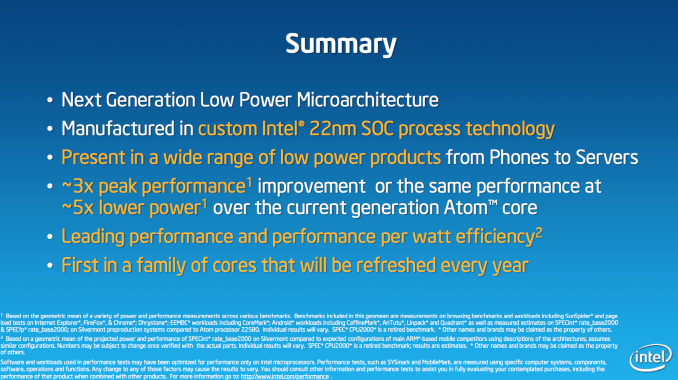Intel’s Silvermont Architecture Revealed: Getting Serious About Mobile
by Anand Lal Shimpi on May 6, 2013 1:00 PM EST- Posted in
- CPUs
- Intel
- Silvermont
- SoCs
Final Words
Silvermont really is Intel’s Conroe for the mobile market, but not in the sense that many have been expecting. Given that success in mobile is so closely tied to device wins, Silvermont alone isn’t enough. Unlike Conroe, a very competitive Silvermont won’t change the world overnight. What Silvermont does however is offer a great foundation for Intel going forward. Conroe lead to Penryn, Nehalem, Westmere, Sandy Bridge, Ivy Bridge and soon, Haswell. It was the platform that Intel could build on regularly by executing on tick-tock. Conroe paved the way for the insane advantage Intel has held onto for the past few years. Silvermont is like Conroe in that it provides that same foundation.
The mobile market is far more competitive than the PC industry was back when Conroe hit. There isn’t just one AMD but many competitors in the SoC space that are already very lean and fast moving. There’s also the fact that Intel doesn’t have tremendous marketshare in ultra mobile. Silvermont may feel a lot like Conroe, but the market it’s competing in is very different. That’s not to say that Intel can’t be successful here; it’s just not going to be easy.
Architecturally Silvermont is very conservative, and that’s not a bad thing. A side effect of not wanting to make Haswell irrelevant by a far lower cost part is the benefit of maintaining power efficiency. Intel joins the ranks of Apple and Qualcomm in intelligently scaling performance while respecting power consumption. Intel’s 22nm process should give Silvermont a lot of runway to use. If it can quickly follow up with 14nm, Silvermont’s power advantage could end up being akin to Conroe’s performance advantage in the mid-2000s.
Even so, Silvermont is long overdue. It’s the first mobile architecture where Intel really prioritized smartphones and tablets, and on paper, it looks very good. Now it’s up to Intel to turn a great architecture into great design wins. From what I’m hearing, we may actually see that happen.











174 Comments
View All Comments
Jaybus - Monday, May 13, 2013 - link
In the full Win 8 tablet market, I don't think any low power SoC is going to be adequate to compete against 13 W Ivy Bridge.1d107 - Tuesday, May 7, 2013 - link
Did I miss memory bandwidth comparison with A6X? Will it support hi-res displays with acceptable performance? And by performance I mean not playing Angry birds on a so 1366x768 or even 1080p, but smooth scrolling and fast text rendering on a 3840x2400 screen. This would be cool for a descent Windows tablet with an external display attached.I'm afraid that by the time Silvermont is released and incorporated into actual products, Apple will have iPad 5 already shipping with A7X chip that will have twice the battery life, while maintaining better performance than A6X. They will need it for the iPad mini, but full-sized iPads will benefit also.
fteoath64 - Tuesday, May 7, 2013 - link
One cannot know what the A7X can deliver but can take a couple of guesses. Here: 1) Optimise Swift further with pipeline shortening but still staying on A9 architecture, 2) Leap to A15 dual core with minimal optimization. On gpu side, it becomes more tricky as Pvr554 being used is Max out at 4 cores, they would have to either jack that up(6 cores ?) or jack up the clock rate.Remember that S800 and T4 products are yet to be announced so there is some time to watch the progression.
Intel's key weakness here is STILL on gpu side. To put 3 cores of PVR 554 would eat a lot of power while giving it respectable performance. Going 1/4 HD4000 is just a dumb idea as the drivers are very bad and will remain so. Again too much power budget to slot in 8EU on SIlvermont quad.
On thing is for sure: Silvermont is going to make a wicked NAS cpu!.
thunng8 - Wednesday, May 8, 2013 - link
1) Swift is not A9 architecture.2) A7X will likely get the next generation PVR graphics chip (SGX Series 6 aka Rogue).
nunomoreira10 - Wednesday, May 8, 2013 - link
considering the power budget, 1/4 hd4000 is quite goodhd4000 consumes around 10w during games, 1/4 with clock cut down and power improvements we should expect 1-2w which is the max they could allow.
drivers are good for the games normally played on tablets.
BSMonitor - Tuesday, May 7, 2013 - link
Awesome review! This is the one we have been waiting for from Windows Phone / Windows Tablets!!Anand, is it the next Lumia that Intel has scored a design win?? x86 Windows 8 on a next gen Lumia??
warezme - Wednesday, May 8, 2013 - link
Sounds like Intel is going hammer time on the mobile SOC arena. It's gonna get ugly but very interesting.futbol4me - Wednesday, May 8, 2013 - link
Can someone out there answer a few questions for me?(1) If Intel Atom powered tablet were running android, do APPS available on Google Play need to be recompiled for the platform?
(2) Will a Windows8 Intel Atom powered tablet have enough horsepower to run android effectively as a Virtual Machine?
Do you think there is enough
biertourist - Wednesday, May 8, 2013 - link
To answer Question #2: Yes. Current Intel Atom tablets can run Android apps ala the "BlueStacks" app currently.rootheday - Thursday, May 9, 2013 - link
re #1, Android apps written in Dalvik/Java require no recompile because they are compiled against a virtual machine spec. Android apps written as "native" against ARM instruction set -> Intel has implemented a binary translation capability called Houdini that converts them to x86 on the fly and optimizes them in the background.